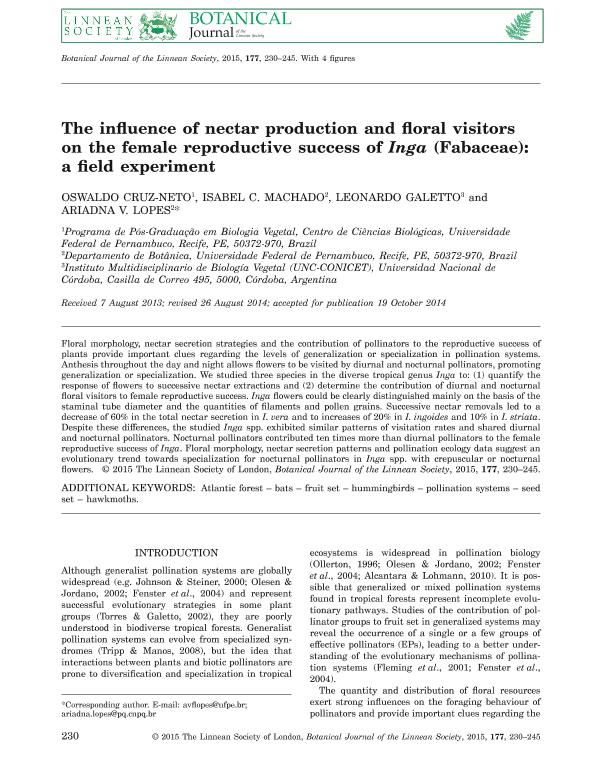Mostrar el registro sencillo del ítem
dc.contributor.author
Cruz Netto, Oswaldo

dc.contributor.author
Machado, Isabel

dc.contributor.author
Galetto, Leonardo

dc.contributor.author
Lopes, Ariadna

dc.date.available
2017-05-12T15:37:53Z
dc.date.issued
2015-02
dc.identifier.citation
Cruz Netto, Oswaldo; Machado, Isabel; Galetto, Leonardo; Lopes, Ariadna; The influence of nectar production and floral visitors on the female reproductive success of Inga (Fabaceae): a field experiment; Wiley Blackwell Publishing, Inc; Botanical Journal Of The Linnean Society; 177; 2; 2-2015; 230-245
dc.identifier.issn
0024-4074
dc.identifier.uri
http://hdl.handle.net/11336/16373
dc.description.abstract
Floral morphology, nectar secretion strategies and the contribution of pollinators to the reproductive success of plants provide important clues regarding the levels of generalization or specialization in pollination systems. Anthesis throughout the day and night allows flowers to be visited by diurnal and nocturnal pollinators, promoting generalization or specialization. We studied three species in the diverse tropical genus Inga to: (1) quantify the response of flowers to successive nectar extractions and (2) determine the contribution of diurnal and nocturnal floral visitors to female reproductive success. Inga flowers could be clearly distinguished mainly on the basis of the staminal tube diameter and the quantities of filaments and pollen grains. Successive nectar removals led to a decrease of 60% in the total nectar secretion in I. vera and to increases of 20% in I. ingoides and 10% in I. striata. Despite these differences, the studied Inga spp. exhibited similar patterns of visitation rates and shared diurnal and nocturnal pollinators. Nocturnal pollinators contributed ten times more than diurnal pollinators to the female reproductive success of Inga. Floral morphology, nectar secretion patterns and pollination ecology data suggest an evolutionary trend towards specialization for nocturnal pollinators in Inga spp. with crepuscular or nocturnal flowers.
dc.format
application/pdf
dc.language.iso
eng
dc.publisher
Wiley Blackwell Publishing, Inc

dc.rights
info:eu-repo/semantics/openAccess
dc.rights.uri
https://creativecommons.org/licenses/by-nc-sa/2.5/ar/
dc.subject
Nectar
dc.subject
Pollination
dc.subject
Inga
dc.subject
Reproductive Success
dc.subject.classification
Ecología

dc.subject.classification
Ciencias Biológicas

dc.subject.classification
CIENCIAS NATURALES Y EXACTAS

dc.title
The influence of nectar production and floral visitors on the female reproductive success of Inga (Fabaceae): a field experiment
dc.type
info:eu-repo/semantics/article
dc.type
info:ar-repo/semantics/artículo
dc.type
info:eu-repo/semantics/publishedVersion
dc.date.updated
2017-05-08T15:34:35Z
dc.identifier.eissn
1095-8339
dc.journal.volume
177
dc.journal.number
2
dc.journal.pagination
230-245
dc.journal.pais
Reino Unido

dc.journal.ciudad
Londres
dc.description.fil
Fil: Cruz Netto, Oswaldo. Universidade Federal de Pernambuco; Brasil
dc.description.fil
Fil: Machado, Isabel. Universidade Federal de Pernambuco; Brasil
dc.description.fil
Fil: Galetto, Leonardo. Consejo Nacional de Investigaciones Científicas y Técnicas. Centro Científico Tecnológico Conicet - Córdoba. Instituto Multidisciplinario de Biología Vegetal. Universidad Nacional de Córdoba. Facultad de Ciencias Exactas Físicas y Naturales. Instituto Multidisciplinario de Biología Vegetal; Argentina
dc.description.fil
Fil: Lopes, Ariadna. Universidade Federal de Pernambuco; Brasil
dc.journal.title
Botanical Journal Of The Linnean Society

dc.relation.alternativeid
info:eu-repo/semantics/altIdentifier/url/https://academic.oup.com/botlinnean/article-lookup/doi/10.1111/boj.12236
dc.relation.alternativeid
info:eu-repo/semantics/altIdentifier/doi/http://dx.doi.org/10.1111/boj.12236
Archivos asociados
